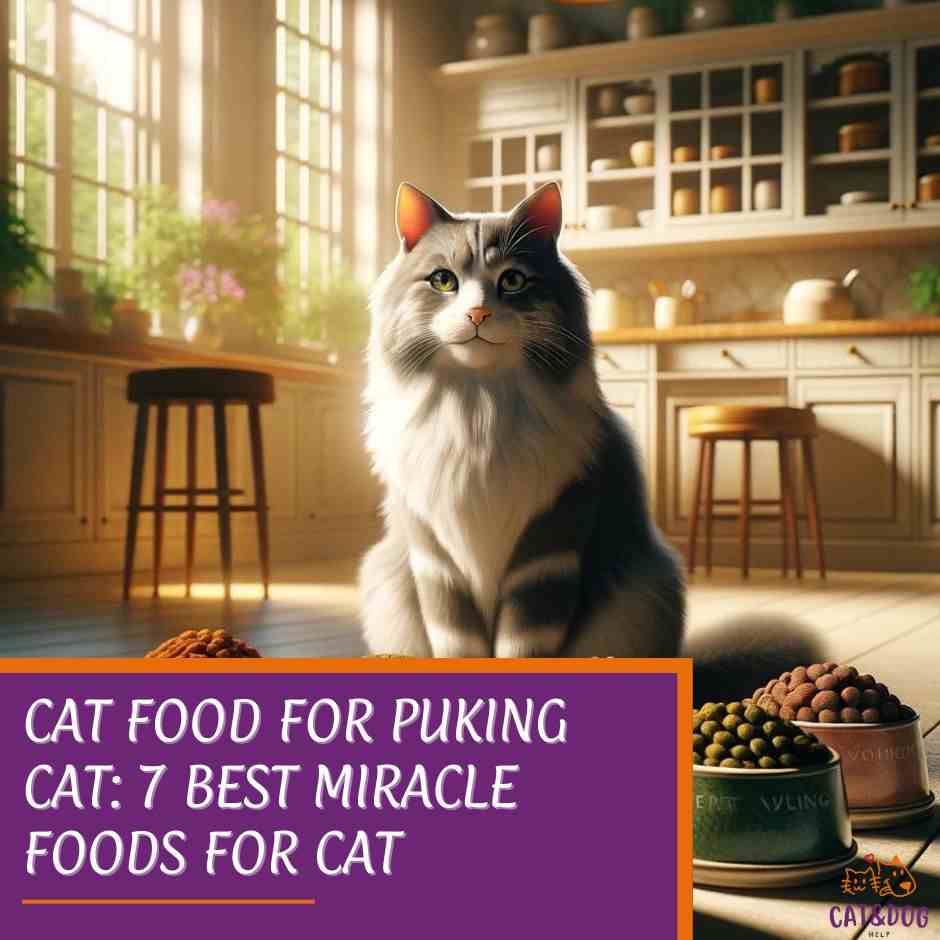Cats are not only our beloved pets but also tiny connoisseurs of their culinary world.
Whether they’re curling up on your lap or pouncing around the house, their diet is crucial to their overall well-being.
One such specific need arises when a cat is frequently vomiting, which can be both a concerning and common issue for cat owners. (1)
Finding the perfect cat food for puking cat means looking for products designed to be gentle on your pet’s digestive system.
The ingredients list should be your go-to guide, as high-quality, easy-to-digest components such as rice or hydrolyzed proteins can provide the necessary nutrients without causing additional stress to the stomach.
It’s also essential to avoid foods with common allergens or too many artificial additives, which can exacerbate the problem rather than help it.
When shopping for cat food for puking cat., you’ll want to consider factors like the kibble size and shape, which should be appropriate for easy consumption and digestion.
Also, pay attention to the balance of fiber content and probiotics for optimal gut health, as these can support regular digestion and reduce the chances of vomiting. (2)
Let this be a guiding paw towards happier, healthier meal times for your cat.
Now, let’s explore further and figure out what’s going to make your furry friend purr with relief and keep the food where it should be – in their belly.
7 Top Picks Cat Food for Puking Cat.
Is your feline friend struggling with an upset tummy more often than you’d like? You’re not alone, and there’s a feast of options to help soothe your purring pal’s digestive woes.
No need to sift through mountains of options—we’ve clawed our way through the data and hunted down the best cat foods that are gentle on sensitive stomachs and tough on kitty puke episodes.
Our list includes top-tier choices packed with easily digestible ingredients and backed by positive furball feedback.
We’ve done the homework so you can skip straight to the solution and get your cat back to their content, playful self.
Let’s find your cat’s match made in food heaven!
#1- IAMS Sensitive Tummy
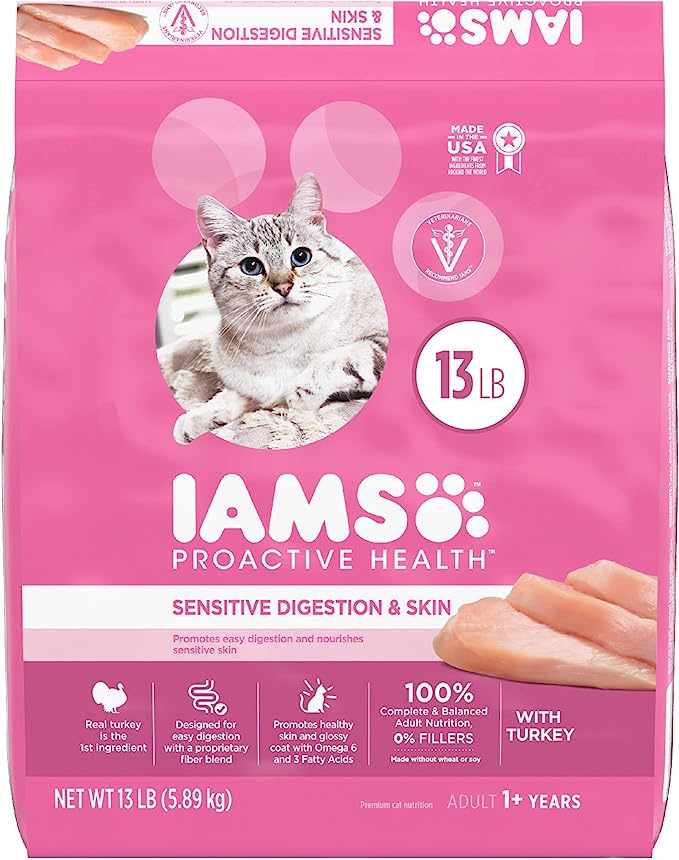
You’ll appreciate how IAMS Sensitive Tummy turns mealtime into a stomach-soothing, fur-smoothing experience for your cat.
Check Best PriceHaving recently welcomed IAMS Sensitive Tummy into your feline friend’s diet, you will notice the laudable difference it makes.
The real turkey-first recipe not only has your kitty purring in anticipation but also working wonders on their digestion.
Prebiotics, and beet pulp—ingredients that sound like they belong in a fancy health food cafe—are actually part of this kibble, ensuring nutrient absorption is top-notch.
If frequent puking was an issue, wave goodbye to those days. This thoughtful blend assists in keeping everything down and disseminating nutrition where it’s needed.
Your cat’s energy levels may have soared, and that’s no surprise given the high-quality protein keeping their muscles robust—a must for those energetic bouts of zoomies.
Let’s talk skin and coat. Omega fatty acids are often raved about in beauty circles and with good reason. Now, they’re serving your cat too.
A silky, shiny coat and skin that’s free from irritation can be a testament to the balanced nutrition they’re receiving.
So while they strut around, you can bask in the pride of providing them with a meal that caters to their inside as much as their outward allure.
Switching to IAMS Sensitive Tummy has been a delight, and while the price tag might make you do a double-take, consider it an investment in your cat’s health.
If your kitty is more of a variety-seeker, you might need to supplement with wet food for some texture change.
And for the poultry-allergic kitties out there, this will, sadly, not be suitable.
But for the average feline with a queasy tummy, this cat food could just be their (and your) happy ending to a messy problem.
#2 – Purina Cat Chow Gentle
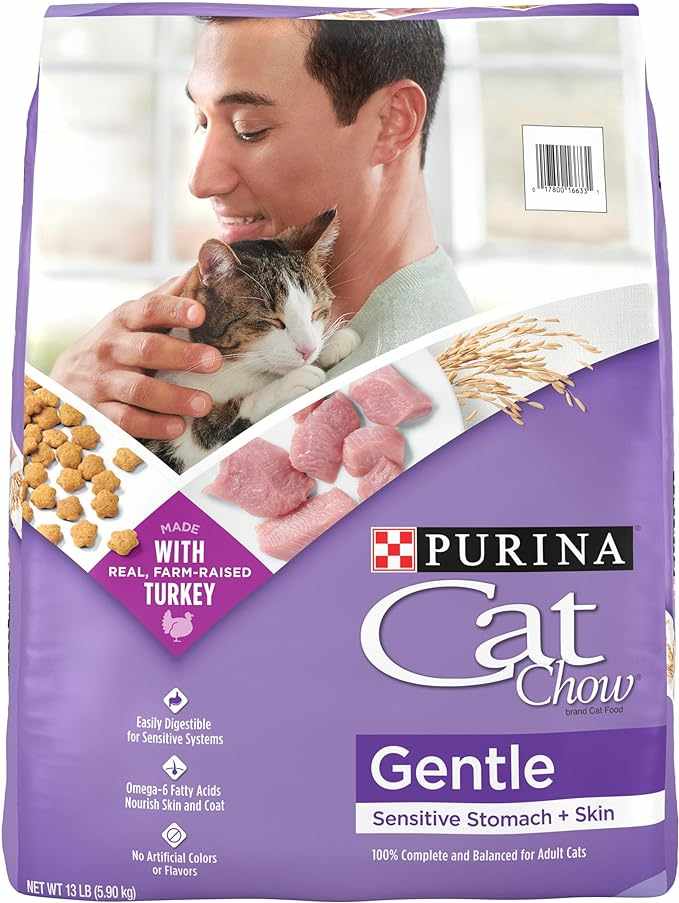
Thinking about switching your cat’s food? If you’ve got a kitty prone to upset tummies, Purina Cat Chow Gentle could be a game-changer.
Check Best PriceIf your feline friend has been battling with bouts of vomiting, it’s tough seeing them go through that.
I’ve been there, and it’s a relief to find a product like Purina Cat Chow Gentle that’s formulated to ease sensitive digestive systems.
After switching to this food, I noticed fewer instances of vomiting, which tells me their digestions were making friends with it.
One of the things I appreciate most is knowing I’m feeding my cat a meal that’s not only nourishing but also kind to her stomach.
Plus, that extra shine on her coat lately? That’s the omega-6 fatty acids at work from the quality ingredients, and let me tell you, she looks fabulous.
Frankly, the peace of mind that comes with no artificial colors or flavors is a big deal to me. I’m all about keeping things as natural as possible, and Purina Cat Chow Gentle aligns with that.
The relief of not dealing with the mess of an upset kitty is something you, too, will value.
You may find, like I did, that while it’s a bit more of an investment, it’s worth the cost for your cat’s comfort and your convenience.
#3 – Wellness CORE Digestive Health
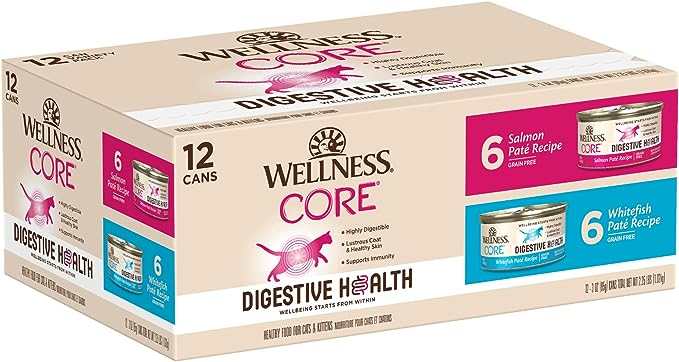
If your cat is spewing more than affection, Wellness CORE Digestive Health could be the answer to calming their sensitive stomach.
Check Best PriceHave you been playing the not-so-fun guessing game of ‘What will my cat keep down today?’ I know the struggle and so does my carpet.
I recently gave Wellness CORE Digestive Health a try and the results? Let’s say I’ve reclaimed my mornings from clean-up patrol.
This grain-free gourmet grub slipped right into our routine, serving up both salmon and whitefish flavors. The pate texture? A hit with my finicky feline who often turns her nose up at chunkier meals.
Here’s why I’m quietly optimistic: the food is crafted without common triggers like corn, wheat, or soy. The vets and nutritionists behind Wellness CORE have their sights set on your kitty’s long-term health, and it shows.
The dietary fibers are a godsend for troubled tummies. Plus, it’s damper than a drizzly day in London, providing hydration some cats might miss out on.
Now for the elephant (or should I say, cat?) in the room. Yes, the price can get you hissing, especially if you’re feeding more than one little lion.
And there’s a chance your cat could snub these savory servings – mine adored the salmon flavor but approached the whitefish with less enthusiasm.
Some sensitive cats might still find something in it they don’t agree with, so keep an eye on how your cat adjusts after their first few feasts.
In short, if your four-legged companion has been more volcano than purr-fect pet lately, turning to Wellness CORE Digestive Health could be well worth it.
Remember to swap foods gradually to give their system time to adapt. Here’s to happier cats and cleaner floors! 🐾
#4 – Blue Tastefuls for Sensitive Cats
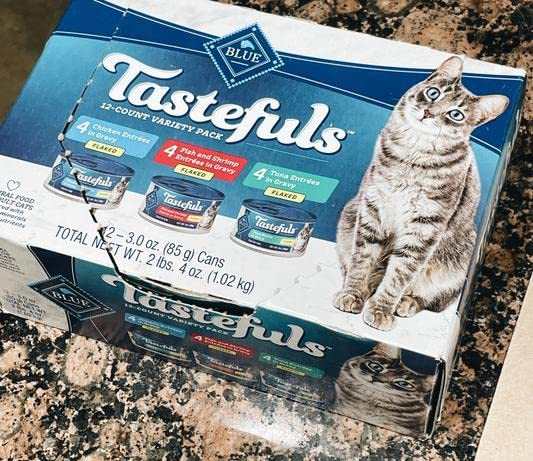
Your cat’s stomach will appreciate a switch to Blue Tastefuls for Sensitive Cats – gentle on their system and appetizing at the same time.
Check Best PriceSwapping to Blue Tastefuls was a game-changer for my finicky felines. The real chicken ingredient must be doing the charm, as they’ve been gobbling it up without the usual tummy troubles.
It’s like they’re saying, “Finally, a meal that gets us!”
The magic seems to lie in the mix of prebiotic fiber that keeps their digestion running as smoothly as a purring kitten.
I’ve noticed a reduction in those unexpected vomit surprises—you know what I’m talking about—and let’s just say cleanups have been less ‘eventful’.
On the flip side, my wallet does feel the pinch a bit more. Yet, given the health benefits, it looks like those extra cents are a small price to pay for peace of mind.
Also, there were a couple of times the bag arrived looking like it had been clawed at by a curious cat, so I’d advise checking your package upon arrival.
Every cat is unique, so keep your fingers crossed that yours isn’t the picky one turning up their nose at this gourmet feast.
Despite the rare reports of feline finickiness and the occasional packaging mishap, this switch might just make both you and your kitty purr with satisfaction.
After all, isn’t a happy, healthy cat the best soundtrack to your life?
#5 – IAMS Cat Kibble
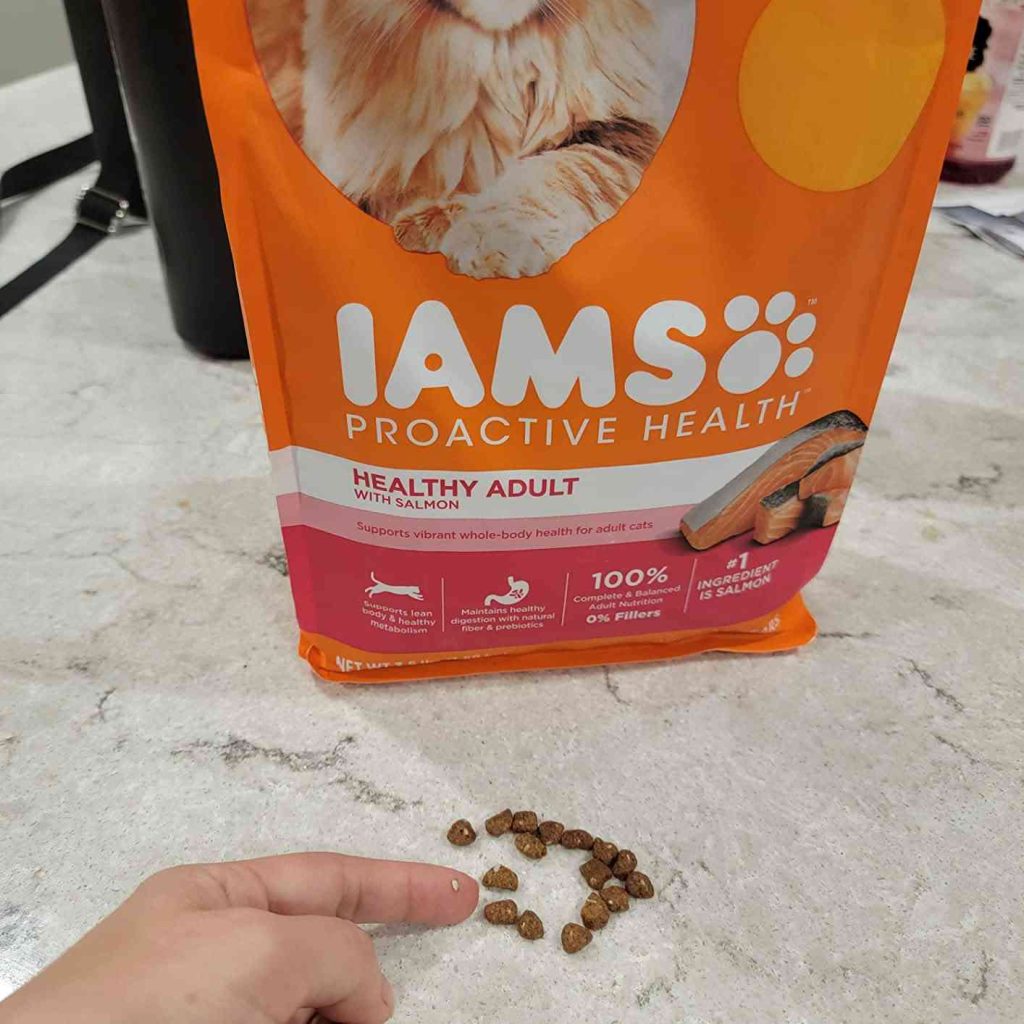
Should you switch to IAMS Proactive Health for your feline friend? Absolutely, if you’re looking for a balance between quality and affordability.
Check Best PriceLooking for a no-fuss meal that your cat won’t turn their nose up at? IAMS Proactive Health with Chicken might just be the answer.
It’s like your cat is getting a hug from the inside out – the prebiotics have delivered a noticeable difference in their digestion, making those icky episodes much less frequent.
The first thing you’ll notice is that your kitty’s coat gleams as if they’ve just come back from a spa day.
The blend of omega-6 and -3 fatty acids in this kibble doesn’t just make them look good, it makes them feel good, too.
And let’s not ignore that protein packs a punch, keeping their muscles strong and ready for action – or, more likely, for a long nap in a sunbeam.
Now, don’t think it’s all sunshine and rainbows.
If your cat is more Garfield than a health guru, they might be a bit picky.
Not every whiskered critter is keen on chicken. And if they’re on a grain-free kick, well, the corn content might be a deal-breaker.
But hey, what can you do? The majority of cats in the shelter where this kibble is a staple seem to thrive on it, so that’s saying something.
To sum up, IAMS Proactive Health Cat Kibble offers the good stuff without breaking the bank, and it’s been a life-changer for our household.
Sure, you might encounter some resistance from the pickiest of eaters, but when it comes down to it, a try is worth it.
If your feline approves, rest easy knowing you’re feeding them a meal that’s both delicious and nourishing.
Plus, with that hefty 22 lb. bag at your doorstep, your back will thank you too.
#6 – Hill’s Science Urinary & Hairball Control
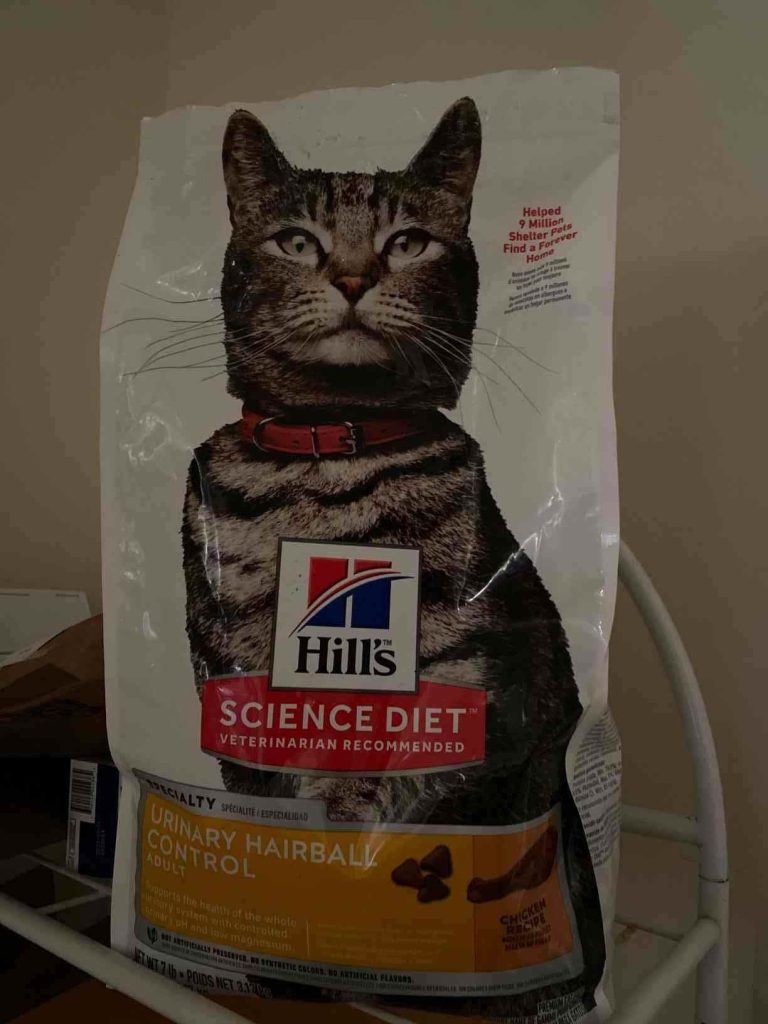
If your furball is coughing up more than just furballs, it’s time to consider switching to a diet that tackles digestion head-on.
Check Best PriceEver find yourself stuck with the not-so-glamorous task of cleaning up after a pukey kitty? I was in your shoes until I stumbled upon Hill’s Science Urinary & Hairball Control cat food.
You might be wondering if this switch is the fix you’ve been hunting for. Spoiler alert: It might just hit the jackpot.
First day feeding Mittens this dry food felt like a breeze.
There I was, pouring those pellets into her bowl, and boy, did she have a field day nibbling away. No more incessant meowing at dinnertime—finally, peace and quiet!
A few weeks in, and you wouldn’t believe the change.
Usually, Mittens’ fur would be everywhere—on the couch, the bed, my favorite sweater— and her hacking up hairballs was an ominous soundtrack to our lives. Not anymore.
It’s like those pellets waved a magic wand over her digestive system. Plus, if your cat’s prone to urinary troubles, you’ve hit the two-for-one special.
No extra cash on vet visits for urinary issues means more in the kitty bank for both of you.
Admittedly, the price tag might make you do a double-take. But can you really put a price on not waking up to unwanted ‘presents’ on the carpet?
If Mittens’ content purr is anything to go by, it’s worth every penny.
Ready to call a truce with your cat’s upset tummy? Go bring some Hill’s Science Diet into your life. Trust me; your mop will thank you.
#7 – Purina ONE Sensitive Systems

If your cat’s tummy troubles are turning mealtime into a mess, Purina ONE Sensitive Systems could be your purr-fect match.
Check Best PriceEver watch your feline friend turn their nose up at dinner? Not with this blend! Purina ONE Sensitive Systems has been a game-changer for our furry food critic.
Boasting real turkey as the star, it’s helped her maintain that lioness-like strength, without the upset stomach.
Every scoop seems to say, “Let’s keep those muscles lean and your tummy serene.”
But hey, food isn’t just about the inside, right?
Well, watching my kitty crunch through this kibble, you’d think it was fish-flavored candy. Who knew dental health could be so delicious?
Bonus points: the antioxidants in this formula are like a shield against those pesky germs, keeping her immune as strong as her purr.
While the benefits are clear as a freshly cleaned litter box, it’s a bummer the packaging isn’t resealable.
Trust me, after one whiff of freshness, you’ll wish you could lock it in like Fort Knox.
And while some kitties might scarf this down like there’s no tomorrow, remember, not all tastes are universal—even in the fussy feline world. Be prepared, some coaxing might be in order.
Now don’t let the price tag give you paws; remember, quality often comes with a few extra coins.
With over 18,000 positive nods online, it’s clear I’m not the only pet parent who’s found their match with Purina ONE Sensitive Systems.
So go ahead, give your cat the stomach-soothing, muscle-boosting meal they deserve—with a side of smile-inducing, tooth-cleaning crunch!
Expert Insights on Vomiting in Cats
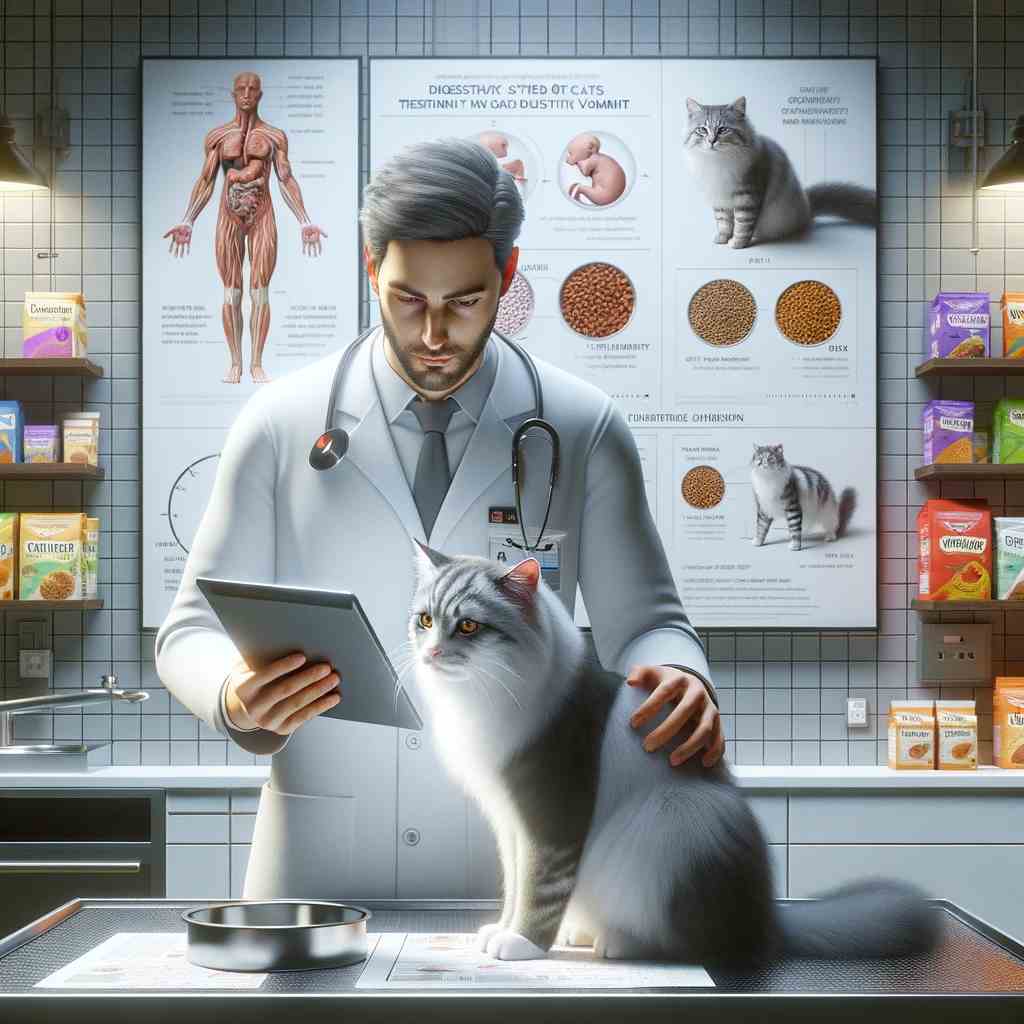
Dietary Factors Affecting Cat Vomiting:
- Food Sensitivities: Just like us, cats can have sensitive stomachs. Identifying and eliminating certain ingredients can help. (3)
- Rich Foods: A rich diet or sudden dietary changes can upset kitty tummies.
- Hairballs: The more grooming, the more hairball formation, which can lead to vomiting. Dietary fiber helps manage this. (4)
Here’s the scoop on how to adjust your cat’s diet:
- Gradual Changes: Introduce new foods slowly, over the course of a week.
- Hydration: Always ensure fresh water is available to help digestion. (5)
- High-Quality Food: Your cat’s food should be high in protein and low in grains. (6)
Veterinarians stress the importance of diet in managing vomiting. They often recommend:
- Limited Ingredient Diets: These can pinpoint food allergies or sensitivities.
- Probiotics: They can aid digestion and reduce upset stomachs.
- Frequent, Small Meals: This can be easier on their digestive system than one or two large meals.
Fidget, Dr. Whiskers’ Siamese cat, stopped her frequent puking after switching to a limited-redient diet, based on the vet’s advice. It’s a common success story!
Remember, your vet’s guidance is the best source for diet advice related to vomiting. Their experience and knowledge are invaluable for your cat’s health.
Understanding Your Cat’s Vomiting

Vomiting in cats can be a messy affair, can’t it? But what’s causing your feline friend to lose their lunch? Sometimes it’s as simple as eating too fast or they encountering a hairball obstacle course in their stomach.
However, it can also point to something requiring a vet’s attention, like infections, eating something they shouldn’t have, or more chronic conditions.
Here’s a quick breakdown of common causes:
- Dietary Indiscretions: A sudden change in diet or snacking on something odd can upset the stomach.
- Hairballs: Cats groom themselves, which leads to the inevitable accumulation of hair in the digestive tract.
- Parasites: Worms can cause stomach upsets. Regular deworming is important.
- Diseases: Kidney disease, hyperthyroidism, or diabetes might be the culprits.
- Toxins: Ingesting poisonous substances will result in vomiting.
Now, when should you be concerned?
- Persistent vomiting: If it lasts more than a day.
- Blood in vomit: This is never normal.
- Lethargy or depression: This could signify a more serious condition.
- Refusal to eat: Skipping more than a couple of meals is a red flag.
Immediate Remedies for Relief
If your cat’s vomiting seems to be a one-off event, here are a few things you can do:
- Fasting: Skip a meal to let their stomach settle.
- Hydration: Ensure they have access to clean water to prevent dehydration.
- Bland Diet: Offer a small amount of plain, boiled chicken or white fish.
These steps provide quick comfort and may help your cat feel better. However, they’re not solutions for more serious health issues. If your cat keeps vomiting, it’s worth a visit to the vet.
Only they can diagnose the issue and suggest a specific treatment or diet that will help keep your purring pal happy and healthy.
Tailored Dietary and Nutritional Advice

Feeding Techniques to Reduce Vomiting:
- Smaller, More Frequent Meals: Instead of two big meals, how about several small ones? This can ease your kitty’s digestion.
- Morning: A portion of their daily intake.
- Noon: A light snack.
- Evening: Another small portion.
- Before bed: A final snack to prevent overnight hunger.
- Gradual Diet Changes: Thinking of switching foods? Take it slow over a week or so to prevent tummy trouble.
- Day 1-3: 75% old food, 25% new food.
- Day 4-6: 50/50 mix.
- Day 7-9: 25% old food, 75% new food.
- Day 10: Complete switch.
- Sensitive Stomach Formula: Foods designed for sensitive stomachs might be your furry friend’s knight in shining armor. Low-fat and high-protein options often work wonders. (7)
- Elevated Feeding Position: Raising the food dish can aid digestion. A stable raised platform should do the trick!
- Interactive Feeders: Slow down a speedy eater with a puzzle feeder. Makes mealtime a fun game, too!
- Consistency: Once you find what works, stick with it. Your cat’s stomach will thank you.
Remember, always keep your vet in the loop! They’ll love to hear about your proactive approach and can provide guidance tailored to your cat’s needs.
Hope these tips help you and your whiskered companion to fewer “oops” moments and more purrs!
Supporting Your Cat Beyond Diet

Yup, even cats can get the blues! Stress doesn’t just mess with their mood—it can lead to a tummy upset and vomiting.
Picture a serene haven for your cat: a peaceful corner, their favorite blanket, and no pesky disturbances.
That’s the dream, right? Creating a soothing environment for your kitty can work wonders in reducing those queasy moments.
Think of it as their zen space, a retreat from the chaos of the world (or just the living room).
But hey, it’s not just about the posh cat condos and jazzy toys—the real magic happens with a good old cuddle and chat.
It may sound a bit kooky, but your empathy and understanding can go a long way.
When your cat’s not feeling 100%, your TLC is the secret ingredient to their recovery. Just imagine how you’d feel with someone reassuring you during a sick day—pretty comforting, huh?
Remember, being in tune with your feline’s emotions is key.
If Mr. Whiskers is hurling more than usual, it might be a sign of a deeper issue. So, keep your eyes peeled and arms open—sometimes, a warm lap is the best medicine.
And you know what they say: “a purr a day keeps the vet away”. Okay, maybe they don’t say that, but it should totally be a thing!
Your mission, should you choose to accept it, involves striking the perfect balance between comfy spaces, engaging toys, and invaluable ‘you and me’ time.
Trust me, your kitty will thank you—with less puke to clean up and more purrs of joy.
Transitioning to a New Diet Safely

When you notice your cat isn’t keeping food down, it might be time to rethink their diet. But swapping out cat food isn’t something you should rush. Let’s guide your kitty to a happier tummy with a safer approach.
First, why the slow switch?
Cats are creatures of habit, and their digestive systems are, too! A sudden diet change can cause stomach upset or even more frequent episodes of vomiting.
Here’s a simple plan to transition to a new diet:
- Days 1-3: Mix about 25% of the new food with 75% of the current food.
- Days 4-6: Increase to a 50/50 blend of new and current food.
- Days 7-9: Shift to 75% new food and 25% current food.
- Day 10 onwards: Serve 100% new food.
Remember to:
- Keep an eye on your cat’s response.
- Offer fresh water at all times.
- Stick to regular feeding times.
| Day Range | Current Food | New Food |
|---|---|---|
| Days 1-3 | 75% | 25% |
| Days 4-6 | 50% | 50% |
| Days 7-9 | 25% | 75% |
| Day 10+ | 0% | 100% |
Take note if your cat’s still feeling queasy during the switch.
It could be more than just pickiness. A quick chat with the vet will put your mind at ease.
To sum it up, easing into a new diet minimizes stress for you and your kitty. Just a dash of patience mixed with careful observation can lead to a smoother transition.
And hey, who knows? Your cat might just end up loving their new gourmet menu!
Buying Guide

Understanding Your Cat’s Needs
Got a cat that’s bringing up their meals more often than a chef samples dishes? You’re not alone! First, you want to ensure your kitty isn’t facing any health issues, so a chat with the vet is a must.
Once you’ve got the all-clear, it’s time to pick the right food.
Key Features to Consider
When shopping, think about these factors:
- Ingredients: Look for high-quality proteins. A simple ingredient list can help minimize the risk of a tummy upset.
- Grain-Free Options: Some cats do better without grains. Could this be a game-changer for yours?
Nutritional Balance
Make sure the food meets the AAFCO guidelines to ensure it’s balanced and complete for your feline friend’s stage of life.
Here’s a quick breakdown to help you make an informed choice:
| Factor | Why It’s Important |
|---|---|
| Protein Source | Helps with growth and repair |
| Carbohydrates | Energy source, but should be minimal |
| Fats | Good for energy and coat health |
| Fiber | Helps with digestion |
| Vitamins & Minerals | Overall health and wellness |
Reading Labels
Get savvy with labels. A higher position on the list means a higher content in the food. And remember, if you’re struggling with all those terms, your vet’s advice can be priceless!
Experimentation
Sometimes, finding the perfect match may require a bit of trial and error.
Keep an eye on your cat’s reaction to different foods. Your patience could lead you to a cleaner floor and a happier kitty!
Final Thoughts
Imagine the joy when your cat’s tummy woes are a thing of the past!
So, take your time, pay attention to the details, and you’ll be the hero with the scoop (of food, that is).
Quick Recap

Let’s go over the high points you’ll want to remember:
- Ingredients Matter: Like a detective, check those cat food labels! You’re looking for high-quality proteins, low carbs, and no nasties like artificial additives.
- Hydration is Key: Have you ever seen a cat turn up their nose at a water bowl? Sometimes, they just don’t drink enough. Wet food can help keep them hydrated and might reduce the upchucks.
| Symptom Check | Possible Cause | Action |
|---|---|---|
| Frequent Vomiting | Food intolerance, illness | Vet visit, dietary assessment |
| Occasional Spew | Hairballs, eating too fast | Brush regularly, slow-feeder bowl |
- Diet Diversity: Some cats have the culinary curiosity of a gourmet chef! Slowly introducing a variety of foods may help pinpoint sensitivities or preferences.
- Portion Control: Size matters. Overfeeding can overwhelm your kitty’s tummy. Smaller, more frequent meals are often better digested.
Remember, it’s not just about the right cat food — it’s about the overall care.
If you’re ever in doubt or the puking persists, chatting with the vet is your best bet! Keep tabs on your cat’s behavior and poop (yes, poop!) for any clues about their health.
Is your head spinning with all this info? No worries, you’ve got this! Managing your cat’s health can be a journey, but you’re not alone.
Keep these points in mind, and your whiskered companion will be on the road to a happier belly in no time!
Frequently Asked Questions

When your kitty’s belly turns queasy and their lunch comes back to haunt you both, finding the right food is paramount. These FAQs hone in on the must-knows to banish the barfs and bring back the purrs.
What specific qualities should I look for in sensitive stomach cat food to help with vomiting?
You’ll want to seek out cat foods with easily digestible proteins, such as hydrolyzed or limited-ingredient formulas.
Also, foods rich in fiber can help regulate your cat’s digestive system.
What ingredients should I avoid in cat food to prevent vomiting?
Steer clear from cat foods containing artificial additives, such as colors and flavors, as well as common allergens like corn, soy, and sometimes dairy or grains.
These might be troublemakers for your feline’s stomach.
Should I feed my vomiting cat wet or dry food?
Generally, wet food can be more palatable and easier to digest, which can help reduce vomiting. However, some cats prefer dry food—they’re individuals after all!
If you go dry, choose a brand specifically formulated for sensitive stomachs.
How quickly should I switch my cat to a new food to reduce vomiting?
Transitioning your cat to new food should be gradual, typically over a 7- to 10-day period.
This prevents further gastrointestinal upset and gives your cat’s system time to adjust to the new grub.
What are the best types of wet cat food to help prevent vomiting in older cats?
For your seasoned companion, premium wet foods with high moisture content, senior-specific formulations, and soft textures are key.
They not only soothe the stomach but cater to their changing dietary needs.
Are there any homemade cat food recipes that help reduce vomiting in cats?
Yes, homemade meals using cooked, lean meats and simple carbohydrates can be gentle on the stomach.
Consult your vet for recipes to ensure they’re complete and balanced for your cat’s specific needs.

